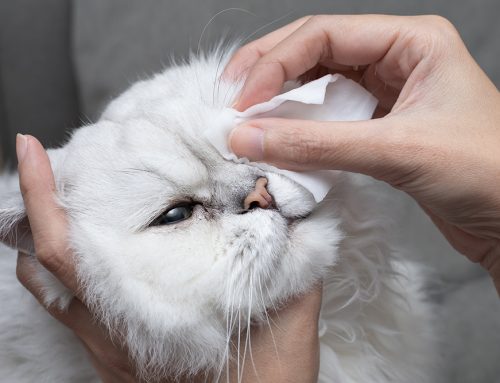Horses have large, beautiful eyes that, unfortunately, are prone to trauma and disease. Many common equine eye diseases are treatable with prompt intervention, but others can progress to blindness or necessitate surgical eye removal. Our Veterinary Vision Center team treats all equine eye diseases, although some occur more frequently. Here is our guide to the most common eye conditions in horses.
#1: Corneal ulcers in horses
Equine eyes are injury-prone because of their large size and their position. The most common injury is a corneal ulcer, which is a scratch or scrape on the cornea’s surface that removes one or more corneal cell layers. Most heal well with antibiotic eye drops and pain medications, but an infection can cause corneal “melting” or a deeper ulcer that may require repairing with grafting surgery. Severe infections can sometimes lead to vision loss from scarring or other complications. Common ulcer signs include squinting, which indicates pain, redness, and discharge.
#2: Keratitis in horses
Keratitis describes corneal surface inflammation, which can be caused by an infection or an overactive immune system attacking normal corneal cells. Fungal keratitis is particularly serious and can be difficult to treat. Keratitis causes a cloudy corneal appearance but is often non-painful. Medical treatments are aimed at reducing inflammation by treating the infection or suppressing the local immune system with topical anti-inflammatories. Severe cases can result in visual impairment from corneal scarring, although surgically removing the damaged corneal layers may restore vision.
#3: Uveitis in horses
Uveitis is inflammation that occurs inside the eye rather than on the eye’s surface. Common causes include systemic infections, such as leptospirosis or equine herpesvirus, eye trauma, or an overactive immune system. When no underlying cause is found, the immune system is often the presumed cause, and the uveitis (i.e., equine recurrent uveitis [ERU]) recurs periodically. Treatment, which includes aggressive topical and systemic anti-inflammatories and medications to address underlying infections, can be difficult. Uveitis complications, including glaucoma and cataracts, are the leading causes of blindness in horses.
#4: Squamous cell carcinoma in horses
Squamous cell carcinoma (SCC) is a common tumor in or around the equine eye. Some breeds, including Belgians and Haflingers, are predisposed to ocular SCC. Surgical tumor removal or complete eye removal (i.e., enucleation) may be recommended, along with other treatments such as chemotherapy or radiation. SCC is locally aggressive and tends to recur after initial treatment. Horses with a history of SCC should receive eye exams at least twice yearly to monitor for tumor recurrence.
UV light also plays a role in SCC development, and predisposed breeds, horses who lack pigment—a natural sunscreen—around their eyes, and horses with a prior tumor history should wear a UV-blocking fly mask to reduce the chances of tumor development.
#5: Eyelid trauma in horses
Horses are prone to trauma to nearly any body part, because they spook easily and frequently act before thinking and injure themselves. They can catch on a sharp object and lacerate their eyelids, which requires quick treatment and repair to prevent infection and restore normal eyelid functioning. Failure to repair the laceration could lead to corneal irritation or ulcers from improper tear film distribution or lashes that rub directly on the eye.
#6: Corpora nigra cysts in horses
The corpora nigra is a dark-colored structure near the horse’s iris that acts as a tiny sunshade and helps to modulate bright light entering the pupil. This structure can develop cysts, which are harmless but can become large or numerous enough to obstruct vision. Laser surgery can deflate these cysts to restore vision.
#7: Conjunctivitis in horses

Conjunctivitis is irritation and swelling of the tissue lining the eyelids and sclera that causes a “pink eye” appearance with swelling, drainage, and diffuse redness. The condition occurs most commonly in the warmer months when flies become a problem. A short course of topical medication usually resolves the issue, and a fly mask can prevent recurrence.
Like humans and other animals, horses can be affected by a wide range of eye conditions, but quick action when you notice a change, such as redness, swelling, tearing, or squinting, can help improve treatment outcomes and prevent potential vision loss. Contact our Veterinary Vision Center team to schedule an evaluation for your horse or to learn more about common eye conditions and available treatments.







Leave A Comment